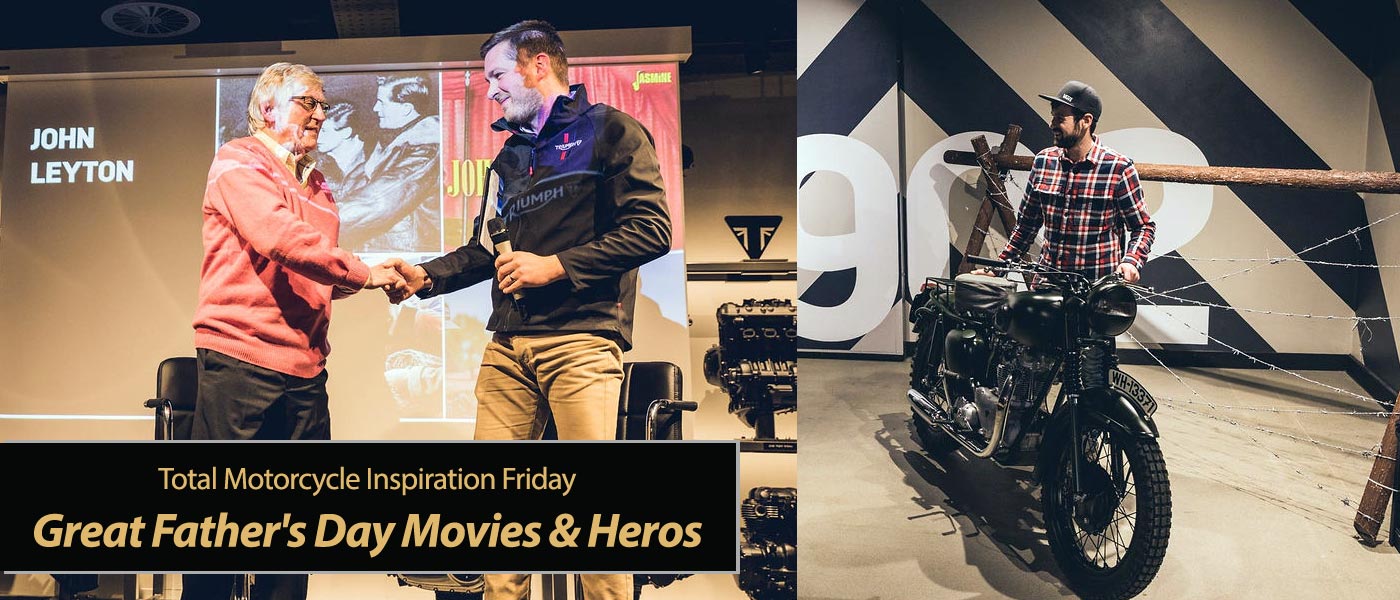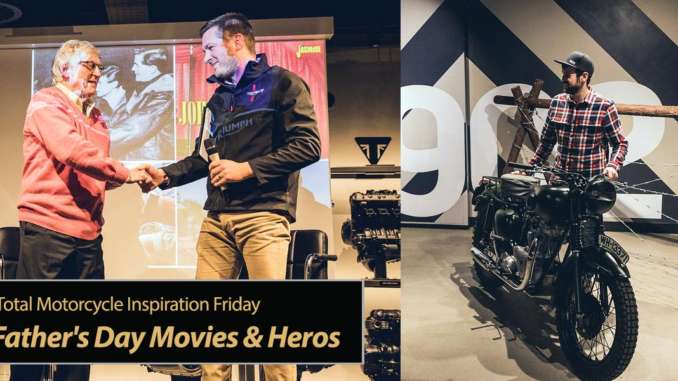
What a better way to celebrate Father’s Day and Inspiration Friday than to showcase Great Father’s Day Movies and Hero Fathers! Guy Martin’s Great Escape is just such a movie. Fathers, Hero’s, action, excitement and of course, Triumph motorcycles! I was fortunate to meet and talk with one of the actual “Great Escape” Stalag Luft3 escapee’s back in the 80’s in the military. It was an honor and a privilege to learn inside information and that they just wanted to get back to their families and their countries.
Motorcycles, action, father’s and Steve McQueen movies, what a great way to spend some time with your father this weekend!
Join us in our community forums discussing other Great Father’s Day Movies and Hero Fathers and talking about your own Dads this weekend!
EXTRAORDINARY EVENING AT THE TRIUMPH FACTORY VISITOR EXPERIENCE, HONOURING THE GREAT ESCAPE WITH SPECIAL GUEST JOHN LEYTON
The evening was designed to:
- Celebrate the audacity and sheer bravery of the Allied soldiers in March 1944 attempting to break out of prisoner of war camp Stalag Luft 3 in Poland.
- Provide previously untold insights into the 1962 film epic that came to immortalize the real ‘Great Escape’ and the iconic motorcycle stunt performed by Bud Ekins, doubling for Steve McQueen, which has become ingrained in film history folklore. Triumph invited John Leyton to appear as special guest for the evening, having been cast into the film as ‘Willie the tunnel king’ by director John Sturges.
- Explain and showcase Triumph’s 2019 partnership with North One Televisionand Guy Martin, which brought the story back to our TV screens with a modern twist.

The over-subscribed evening on Thursday 30th January 2020 contained:
- A live, big screen airing of North One production’s 2019 Channel 4 television show ‘Guy Martin’s Great Escape’.
- A live demonstration of one of the world’s most iconic and valuable motorcycles – the original Triumph TR6 from the 1962 film ‘The Great Escape’ as ridden by Steve McQueen and Bud Ekins for the world-renowned jump – was ridden onto centre stage for the exclusive, delighted audience.
- The public debut of the distinctive Scrambler 1200 XE motorcycle custom built and painted by Triumph in collaboration with Guy Martin for his attempt to recreate and improve on the original 1962 jump.
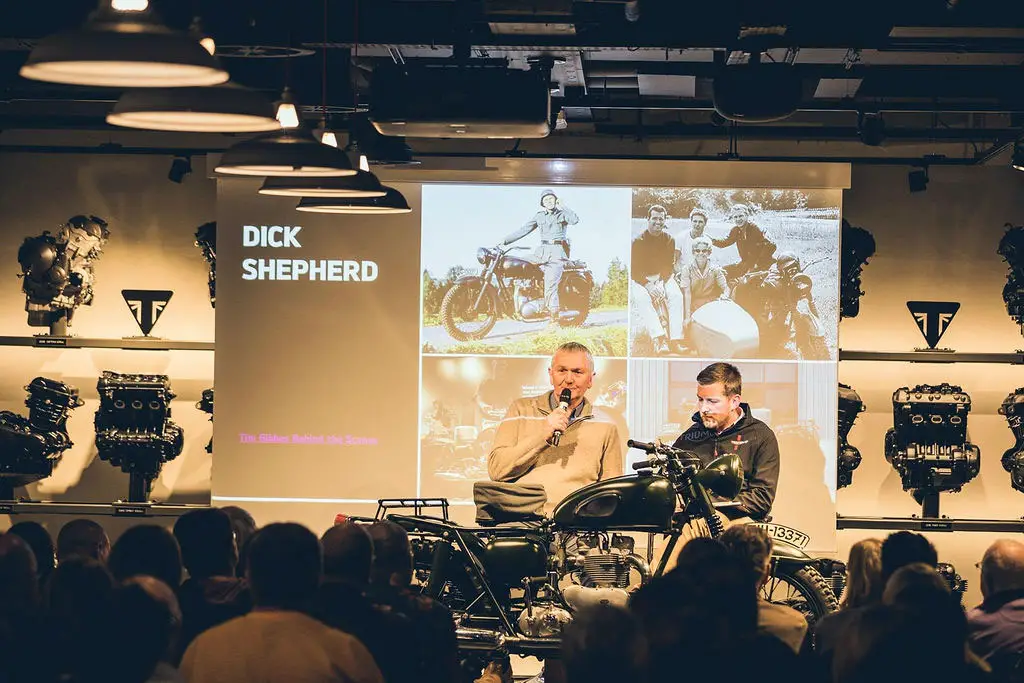
John Leyton starred in the original 1962 epic Great Escape film as ‘Willie the tunnel king’, alongside Charles Bronson and is one of the last surviving cast members of the original, classic movie. John delivered his own unique behind-the-scenes insight into the filming and production of ‘The Great Escape’, revealing little-known facts about the world-famous jump and telling stories of what it was like to work alongside Steve McQueen and other members of the all-star cast.
There are not many people in the world who can say that Steve McQueen taught them how to ride a motorcycle, but John Leyton is one of them. John said:
“Everyone was riding bikes on the movie set. There were bikes everywhere! Steve McQueen asked me if I could ride a bike and unfortunately I couldn’t. Steve promptly took it upon himself to teach me how to ride!”
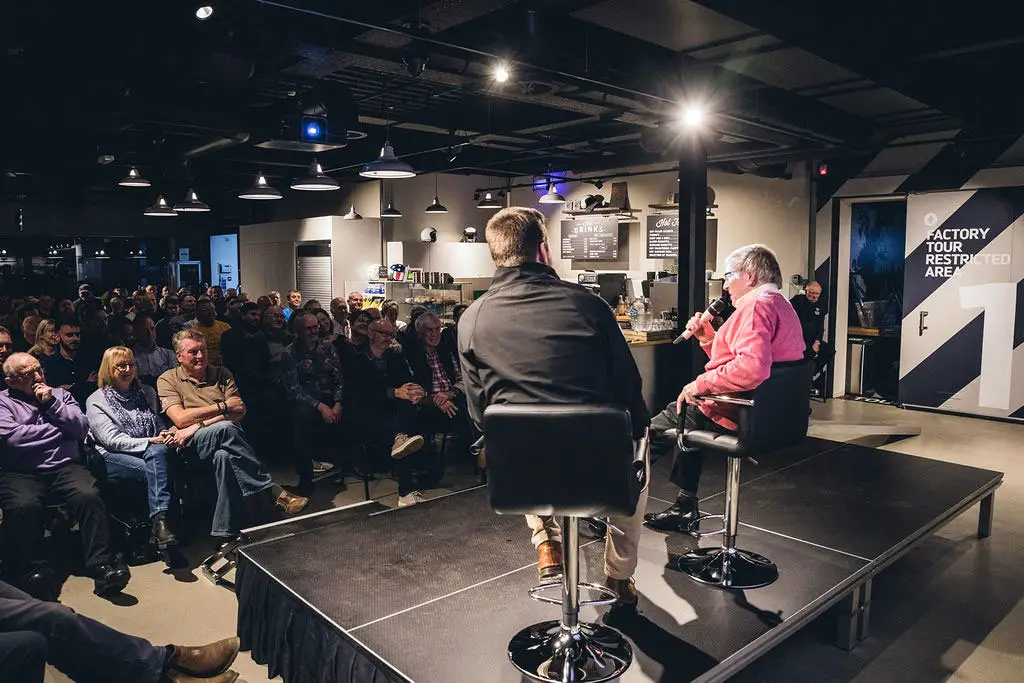
Other special guests of the evening included Dick Shepherd, an enthusiastic collector of Triumph motorcycles with a driving passion for the history of motorcycles. Dick is the custodian of the original Triumph TR6 Great Escape film bike, which is displayed permanently at the Triumph Factory Visitor Experience. During this commemorative evening Dick rode this famous bike onto stage for the lucky audience.
The distinctive Scrambler 1200 XE that was custom built by Triumph with Guy Martin’s assistance was also ridden onto the stage in its first public appearance. His 2019 attempt to recreate the original jump was designed around this bike, to honour the original role of the Triumph TR6 in the 1962 film.
Guy’s plan in the television show also involved jumping further over the additional and higher fence, an exact replica of the original 1962 German-based set. Steve McQueen’s fictional character had attempted landing in Switzerland to ultimate freedom, so the barbed-wire covered fences have come to symbolise freedom for fans the world over.
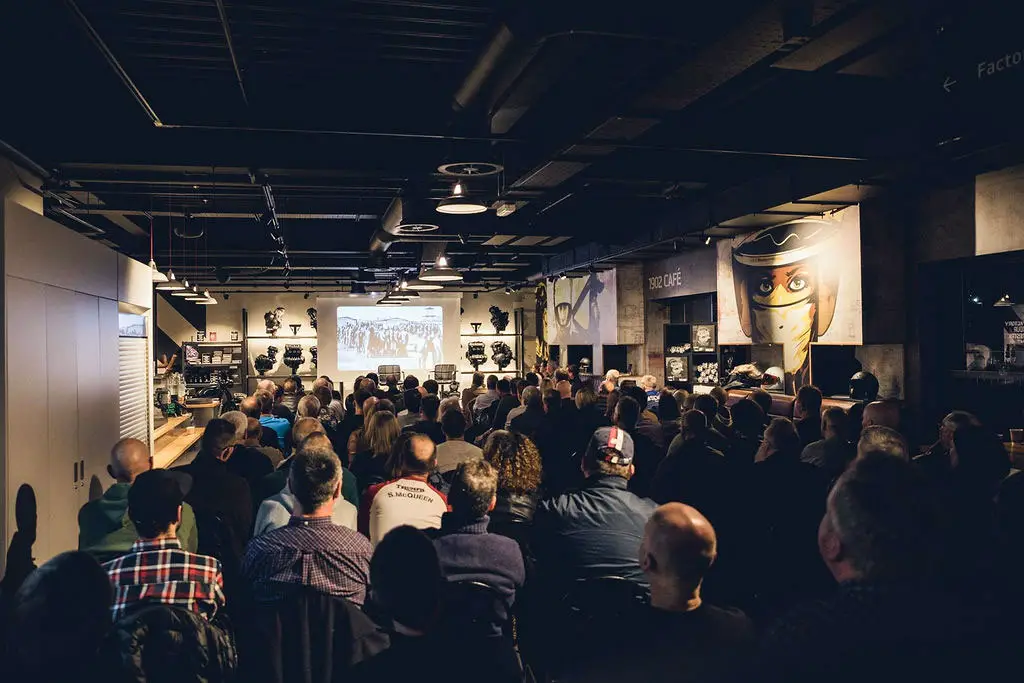
Triumph’s Chief of Engineering Stuart Wood detailed for the audience the modifications required to set the bike up for the Bavarian jump seen on Channel 4’s Guy Martin’s Great Escape.
Stuart Wood said: “It was really interesting, we looked at the suspension both front and in particular the rear to check for any required alterations, and after in-depth analysis, we realised we could use the Scrambler 1200’s original Öhlins adjustable suspension set up with minimal modification – it is just so good.”
For all film and motorcycle fans who attended, this really was a night to remember. The next special exhibition at the Triumph Factory Visitor Experience will feature the history of the Daytona with some racing legends and never seen before bikes.
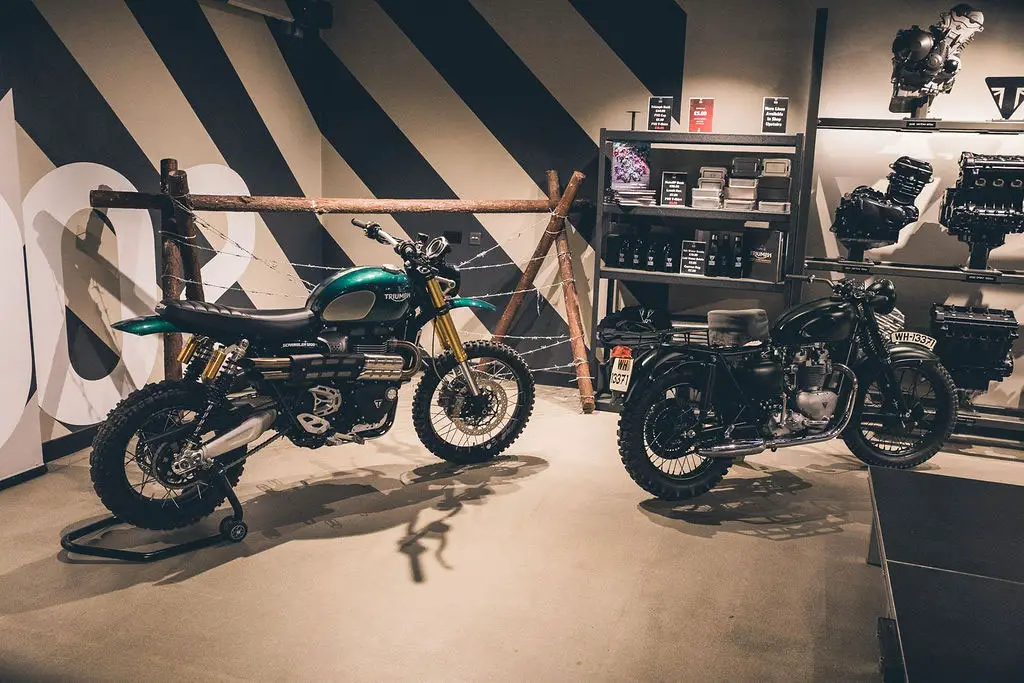
About Triumph
- The Triumph Moto2™ 765cc race engine is a development of the class-leading Street Triple RS 765cc road motorcycle with the same visceral soundtrack.
- First established in 1902, Triumph Motorcycles celebrated 115 years of motorcycle manufacture in 2017. For more than three decades, Triumph Motorcycles has been based in Hinckley, Leicestershire, and has produced iconic bikes that perfectly blend authentic design, character, charisma and performance.
- Building around 65,000 bikes per year, Triumph is the largest British motorcycle manufacturer and has around 650 dealers across the world.
- This focus, innovation and engineering passion has today created a broad range of bikes suited to all motorcycle riders, including the iconic new Scrambler 1200, epic Speed Triple, the game changing all new Street Triple 765, the class defining Tiger 900, transcontinental Tiger 1200, iconic Triumph Bonneville family including the stunning Speed Twin, Bonneville Bobber, legendary Thruxton, accessible Street Twin, Street Scrambler and iconic Bonneville T120 and T100, plus an exciting and accessible A2 range of Triumph motorcycles.
- Triumph currently employs around 2,000 personnel worldwide and has subsidiary operations in the UK, North America, France, Germany, Spain, Italy, Japan, Sweden (Scandinavia), Benelux, Brazil, India and Thailand as well as a network of independent distributors. Triumph has manufacturing facilities in Hinckley, Leicestershire, and Thailand plus CKD facilities in Brazil and India.
- The Triumph Bonneville, famously named to celebrate Triumph’s 1956 land speed record on the Bonneville Salt Flats in Utah, USA, was the original British superbike and a race-winner straight out of the crate, chosen by famous motorcyclists of the past for its legendary handling, style, and character. It’s that handling, character and style, married to modern rider-focused technology that makes the new Bonneville family THE authentic modern classic choice today.
- Triumph has a glorious racing history, competing in and winning races in almost every class and field of motorcycle sporting achievement. From winning the second ever Isle of Man TT in 1908, through to 1960s road and track domination in Europe and America, right up to contemporary racing achievements with the 675cc Triumph triple powered 2014 Daytona 200 win, the 2014 Isle of Man Supersports TT win, the 2014 and 2015 British Supersports titles and World SuperSport racing, and again this year, with another victory at the Isle of Man Supersports TT, piloted by Peter Hickman. And of course with the new generation 765cc triple engine powering the 2019 Moto2™ championship, Triumph’s racing legend continues.
The history behind “The Great Escape” (thanks to Wikipedia)
The “Great Escape” (1944)
Background
In March 1943, Royal Air Force Squadron Leader Roger Bushell conceived a plan for a mass escape from the North Compound, which took place on the night of 24/25 March 1944.[3] He was being held with the other British and Commonwealth airmen and he was in command of the Escape Committee that managed all escape opportunities from the north compound. Falling back on his legal background to represent his scheme, Bushell called a meeting of the Escape Committee to advocate for his plan.
“Everyone here in this room is living on borrowed time. By rights we should all be dead! The only reason that God allowed us this extra ration of life is so we can make life hell for the Hun … In North Compound we are concentrating our efforts on completing and escaping through one master tunnel. No private-enterprise tunnels allowed. Three bloody deep, bloody long tunnels will be dug – Tom, Dick and Harry. One will succeed!”
Group captain Herbert Massey, as senior British officer, authorised the escape attempt which would have good chance of success; in fact, the simultaneous digging of three tunnels would become an advantage if any one of them was discovered, because the guards would scarcely imagine that another two were well underway. The most radical aspect of the plan was not the scale of the construction, but the number of men intended to pass through the tunnels. While previous attempts had involved up to 20 men, in this case Bushell was proposing to get over 200 out, all wearing civilian clothes and some with forged papers and escape equipment. As this escape attempt was unprecedented in size, it would require unparalleled organisation; as the mastermind of the Great Escape, Roger Bushell inherited the codename of “Big X”. More than 600 prisoners were involved in the construction of the tunnels.
Tunnels
Three tunnels, Tom, Dick, and Harry were dug for the escape. The operation was so secretive that everyone was to refer to each tunnel by its name. Bushell took this so seriously that he threatened to court-martial anyone who even uttered the word “tunnel”.
Tom began in a darkened corner next to a stove chimney in hut 123 and extended west into the forest. It was found by the Germans and dynamited.
Dick’s entrance was hidden in a drain sump in the washroom of hut 122 and had the most secure trap door. It was to go in the same direction as Tom and the prisoners decided that the hut would not be a suspected tunnel site as it was further from the wire than the others. Dick was abandoned for escape purposes because the area where it would have surfaced was cleared for camp expansion. Dick was used to store soil and supplies and as a workshop.
Harry, which began in hut 104, went under the Vorlager (which contained the German administration area), sick hut and the isolation cells to emerge at the woods on the northern edge of the camp. The entrance to “Harry” was hidden under a stove. Ultimately used for the escape, it was discovered as the escape was in progress with only 76 of the planned 220 prisoners free. The Germans filled it with sewage and sand and sealed it with cement.
After the escape, the prisoners started digging another tunnel called George, but this was abandoned when the camp was evacuated.
Tunnel construction
The tunnels were very deep – about 9 m (30 ft) below the surface. They were very small, only 0.6 m (2 ft) square, though larger chambers were dug to house an air pump, a workshop and staging posts along each tunnel. The sandy walls were shored up with pieces of wood scavenged from all over the camp, much from the prisoners’ beds (of the twenty or so boards originally supporting each mattress, only about eight were left on each bed). Other wooden furniture was also scavenged.
End of “Harry”
Other materials were also used, such as Klim tin cans that had held powdered milk supplied by the Red Cross for the prisoners. The metal in the cans could be fashioned into various tools and items such as scoops and lamps, fuelled by fat skimmed off soup served at the camp and collected in tiny tin vessels, with wicks made from worn clothing. The main use of the Klim tins was for the extensive ventilation ducting in all three tunnels.
As the tunnels grew longer, a number of technical innovations made the job easier and safer. A pump was built to push fresh air along the ducting, invented by Squadron Leader Bob Nelson of 37 Squadron. The pumps were built of odd items including pieces from the beds, hockey sticks and knapsacks, as well as the Klim tins.
The usual method of disposing of sand from all the digging was to scatter it discreetly on the surface. Small pouches made of towels or long underpants were attached inside the prisoners’ trousers; as they walked around, the sand could be scattered. Sometimes, they would dump sand into the small gardens they were allowed to tend. As one prisoner turned the soil, another would release sand while they both appeared to be in conversation. The prisoners wore greatcoats to conceal the bulges from the sand, and were referred to as “penguins” because of their supposed resemblance. In sunny months, sand could be carried outside and scattered in blankets used for sun bathing; more than 200 were used to make an estimated 25,000 trips.
The Germans were aware that something was going on but failed to discover any of the tunnels until much later.[citation needed] To break up an escape attempt, nineteen of the top suspects were transferred without warning to Stalag VIIIC. Of those, only six had been involved with tunnel construction. One of these, a Canadian called Wally Floody, was actually originally in charge of digging and camouflage before his transfer.
Eventually the prisoners felt they could no longer dump sand above ground because the Germans became too efficient at catching them doing it. After “Dick”‘s planned exit point was covered by a new camp expansion, the decision was made to start filling it up. As the tunnel’s entrance was very well-hidden, “Dick” was also used as a storage room for items such as maps, postage stamps, forged travel permits, compasses and clothing.[21] Some guards cooperated by supplying railway timetables, maps and many official papers so that they could be forged. Some genuine civilian clothes were obtained by bribing German staff with cigarettes, coffee or chocolate. These were used by escaping prisoners to travel from the camp more easily, especially by train.
The prisoners ran out of places to hide sand, and snow cover made it impractical to scatter it undetected. Under the seats in the theatre there was a large empty space but when it was built the prisoners had given their word not to misuse the materials; the parole system was regarded as inviolate. Internal “legal advice” was taken and the SBOs (Senior British Officers) decided that the completed building did not fall under the parole system. A seat in the back row was hinged and the sand dispersal problem solved.
German prison camps began to receive larger numbers of American prisoners. The Germans decided that new camps would be built specifically for US airmen. To allow as many people to escape as possible, including the Americans, efforts on the remaining two tunnels increased. This drew attention from guards and in September 1943 the entrance to “Tom” became the 98th tunnel to be discovered in the camp[citation needed]; guards in the woods had seen sand being removed from the hut where it was located. Work on “Harry” ceased and did not resume until January 1944.
Tunnel “Harry” completed
“Harry” was finally ready in March 1944. By then the Americans, some of whom had worked on “Tom”, had been moved away; despite its portrayal in the Hollywood film, only one American, Major Johnnie Dodge, participated in the “Great Escape”. Previously, the attempt had been planned for the summer for its good weather, but in early 1944 the Gestapo visited the camp and ordered increased effort to detect escapes. Rather than risk waiting and having their tunnel discovered, Bushell ordered the attempt be made as soon as it was ready. Many Germans willingly helped in the escape itself. The film suggests that the forgers were able to make near-exact replicas of just about any pass that was used in Nazi Germany. In reality, the forgers received a great deal of assistance from Germans who lived many hundreds of miles away on the other side of the country. Several German guards, who were openly anti-Nazi, also willingly gave the prisoners items and assistance of any kind to aid their escape.
In their plan, of the 600 who had worked on the tunnels only 200 would be able to escape. The prisoners were separated into two groups. The first group of 100, called “serial offenders,” were guaranteed a place and included 30 who spoke German well or had a history of escapes, and an additional 70 considered to have put in the most work on the tunnels. The second group, considered to have much less chance of success, was chosen by drawing lots; called “hard-arsers”, they would have to travel by night as they spoke little or no German and were only equipped with the most basic fake papers and equipment.
The prisoners waited about a week for a moonless night, and on Friday 24 March the escape attempt began. As night fell, those allocated a place moved to Hut 104. Unfortunately for the prisoners, the exit trap door of Harry was frozen solid and freeing it delayed the escape for an hour and a half. Then it was discovered that the tunnel had come up short of the nearby forest; at 10.30 p.m. the first man out emerged just short of the tree line close to a guard tower. (According to Alan Burgess, in his book The Longest Tunnel, the tunnel reached the forest, as planned, but the first few trees were too sparse to provide adequate cover). As the temperature was below freezing and there was snow on the ground, a dark trail would be created by crawling to cover. To avoid being seen by the sentries, the escapes were reduced to about ten per hour, rather than the one every minute that had been planned. Word was eventually sent back that no-one issued with a number above 100 would be able to get away before daylight. As they would be shot if caught trying to return to their own barracks, these men changed back into their own uniforms and got some sleep. An air raid then caused the camp’s (and the tunnel’s) electric lighting to be shut down, slowing the escape even more. At around 1 a.m., the tunnel collapsed and had to be repaired.
Despite these problems, 76 men crawled through to freedom, until at 4:55 a.m. on 25 March, the 77th man was spotted emerging by one of the guards. Those already in the trees began running, while a New Zealand Squadron Leader Leonard Henry Trent VC who had just reached the tree line stood up and surrendered. The guards had no idea where the tunnel entrance was, so they began searching the huts, giving men time to burn their fake papers. Hut 104 was one of the last to be searched, and despite using dogs the guards were unable to find the entrance. Finally, German guard Charlie Pilz crawled back through the tunnel but found himself trapped at the camp end; he began calling for help and the prisoners opened the entrance to let him out, finally revealing its location.
An early problem for the escapees was that most were unable to find the way into the railway station, until daylight revealed it was in a recess of the side wall to an underground pedestrian tunnel. Consequently, many of them missed their night time trains, and decided either to walk across country or wait on the platform in daylight. Another unanticipated problem was that this was the coldest March for thirty years, with snow up to five feet deep, so the escapees had no option but to leave the cover of woods and fields and stay on the roads.
Following the escape, the Germans made an inventory of the camp and uncovered how extensive the operation had been. Four thousand bed boards had gone missing, as well as 90 complete double bunk beds, 635 mattresses, 192 bed covers, 161 pillow cases, 52 twenty-man tables, 10 single tables, 34 chairs, 76 benches, 1,212 bed bolsters, 1,370 beading battens, 1219 knives, 478 spoons, 582 forks, 69 lamps, 246 water cans, 30 shovels, 300 m (1,000 ft) of electric wire, 180 m (600 ft) of rope, and 3,424 towels. 1,700 blankets had been used, along with more than 1,400 Klim cans. Electric cable had been stolen after being left unattended by German workers; because they had not reported the theft, they were executed by the Gestapo.Thereafter each bed was supplied with only nine bed boards, which were counted regularly by the guards.
We hope you enjoyed this week’s Inspiration Friday: Great Father’s Day Movies and Hero Fathers and wish to thank Triumph and Wikipedia for inspiring us to bring it to you! Stay tuned each day and every week for exciting new and unique articles you won’t want to miss and won’t find anywhere else.


